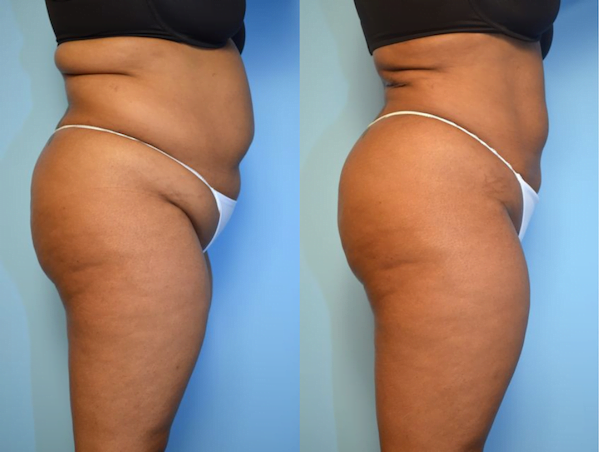What You Need to Know About the First Case of Fatal Implant-Associated Lymphoma After Buttock Enhancement

The first known case of gluteal implant associated anaplastic large cell lymphoma (GIA-ALCL) was reported earlier this year, and unfortunately, the disease claimed the life of a patient. The 49-year-old patient developed symptoms including fluid accumulation and abdominal pain one year after having textured silicone gluteal implants placed and was diagnosed with ALCL shortly thereafter. Unfortunately, even after undergoing chemotherapy and other treatments, the patient died from complications of ALCL.
My heart goes out to the patient’s family, and I sincerely hope that this remains an isolated case. However, the simple fact that another type of textured implant has been linked to ALCL deserves attention. Patient safety is our foremost concern as plastic surgeons, and we need to carefully examine any new risks that come up with any procedure.
BIA-ALCL vs GIA-ALCL. There are some key differences to note.
First, it’s important to understand that there are many different variations of ALCL. Breast implant associated anaplastic large cell lymphoma, or BIA-ALCL, is one variation. Now we have evidence that gluteal implant associated ALCL, or GIA-ALCL, is another.
This case of GIA-ALCL was aggressive and behaved very differently than anything we have seen with breast implant associated ALCL, which is slow-growing and in most cases fully treatable with breast implant removal and capsulectomy.
Although very rare, BIA-ALCL is a known risk with textured breast implants. According to the most recent data, the risk of developing BIA-ALCL lies between 1 in 3,800 and 1 in 30,000 for patients who currently have or have had textured breast implants at some point. To date, approximately 573 unique cases have been reported to the FDA, while tens of millions of women in the U.S. currently have breast implants.
What is more, BIA-ALCL is typically slow-growing. In almost all cases, patients developed symptoms such as seroma or breast pain, but were diagnosed long before the cancer could spread, and were fully cured of the disease by undergoing breast implant removal and capsulectomy. To date, only 9 deaths have occurred among approximately 660 BIA-ALCL patients, and in all of the fatal cases, the patient received a late diagnosis.
This case of GIA-ALCL behaved very differently than anything we have seen with BIA-ALCL. The cancer was very aggressive—while the patient sought treatment shortly after developing symptoms, her condition deteriorated so quickly that surgeons did not have time to perform explantation surgery before more aggressive treatments were required. Also, in addition to seroma around the implant, the patient had fluid masses in her lungs containing ALCL cells and skin ulceration in the buttocks.
What can we take away from this news?
First, that any sort of implanted device—whether breast implants, butt implants, an artificial hip or knee—carries some risk of an adverse reaction. In most cases and with most devices, the benefits of having the device greatly outweigh the associated risks for the patient.
However, when it comes to butt implants, I feel the risks outweigh potential benefits. Firstly, we now know that textured gluteal implants may carry risk of a more deadly form of ALCL than breast implants. Additionally, there are many other issues with gluteal implants which are already well-known, including capsular contracture, infection, malposition, and visible edges.
If this leads you to wonder if Brazilian butt lift (a procedure that doesn’t use implants) is a better alternative, think again: it has an even higher mortality rate. However, there is an alternative approach.
Know the risks of buttock enhancement before choosing a procedure
I’ve already mentioned the risks of gluteal implants, but gluteal fat injections, a.ka. Brazilian butt lift surgery, currently has the highest mortality rate of any cosmetic surgery procedure, estimated to be as high as 1 in 3,000. In fact, the American Society for Aesthetic Plastic Surgery, American Society of Plastic Surgeons, and several other organizations formed a task force in 2018 to review the safety of the procedure after a handful of patients died from complications of Brazilian butt lift surgery, and Florida has placed emergency restrictions on the procedure.
Granted, these procedures are often successful when performed by a very experienced plastic surgeon in a safe, accredited surgery center—but serious complications are not rare enough for me to feel comfortable performing either gluteal implant surgery or Brazilian butt lift surgery at my practice. Instead, I opt for safe, proven methods.
How can I get a larger butt without implants or fat injections?
Many people focus on ways they can enhance an area by adding to it—but one can take a completely different approach and instead reduce the size of surrounding areas. By using liposuction to remove fat from the lower back, abdomen, hips, thighs, and/or under the butt, I can make the buttocks appear larger in comparison. Additionally, this creates a more pleasing, hourglass shape, all without having to modify the buttocks themselves.

Liposuction can achieve the look of Buttock Enhancement procedures without implants or gluteal fat injections.
Most importantly, when performed correctly by an experienced, board certified plastic surgeon, liposuction is a very low-risk procedure that can yield dramatic, lasting results with a relatively quick recovery.
I welcome your questions
I will continue to follow both BIA-ALCL and GIA-ALCL and stay abreast of any new developments to ensure I can provide the safest, most effective patient care. If you have any questions, please feel free to reach out to me. I am always happy to help.